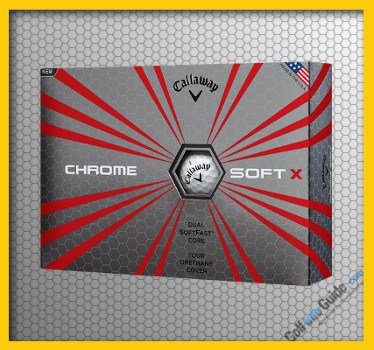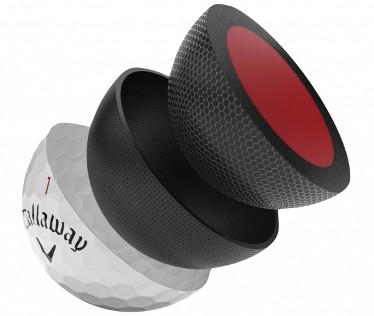
© Callaway Golf
Callaway Chrome Soft X Golf Ball Review
Spin: High
Dimples: 332 HEX Aerodynamics
Compression: Mid
Category Comparison: Tour
Spec: 4-Piece/Layers
Cover: Thermoplastic Urethane
Core: Dual SoftFast Core
The 2017 version of the Callaway Chrome Soft X is built and designed as an improvement or at least an alternative for last year's 4-piece Chrome Soft. The Callaway Chrome Soft X is somewhat different from the previous generation, as it will provide you with more spin from the fairway and off the tee. This golf ball retails for $40 a dozen, which is not cheap, but for that kind of money you'll receive a four piece/90 compression ball, designed with an inner core, an outer core, an urethane cover featuring hexagonal dimples and a mantle layer. To get the picture, the regular Chrome Soft has an overall compression of 75. While the 2016 Chrome Soft was designed with tour players in mind and had a moderate success on tour, some players complained about the ball's low spin performance. The Callaway Chrome Soft X was created to mitigate this issue, i.e. to feel just like the Chrome Soft via the company's proprietary Dual SoftCore technology, but with increased spin throughout the golf-bag.
The cover of the Callaway Chrome Soft X is firmer, yet still very soft for a urethane cover. Also, the Dual SoftFast core is a tad firmer than in the Chrome Soft golf ball, but now it's larger, helping with maintaining the overall feel for the Callaway Chrome Soft X. In real life, the Chrome Soft X will fly longer than the regular Chrome Soft. However, the Callaway Chrome Soft X was not designed to be a better performer, as both golf balls are equally good performance wise, they're just addressed to different type of players. Introduced on February 3rd, the Callaway Chrome Soft X is available in white and yellow colorways. The Truvis versions for Chrome X will also arrive in yellow/black starting with March 2017.
Golf Ball Videos:
- Compression Video
- Spin Video
- Dimples Video
- Golf Ball Brands Video
- Titleist Video
- Understanding Spin Video
Categories Explained:
Value/Recreational/Distance – Designed for mid- to high-handicap golfers with swing speeds below 90 mph; typically feature two-piece construction and firm covers; promote greater distance over high spin rates. Examples: Pinnacle Gold, Slazenger RAW Distance
Premium – Designed for low- to mid-handicap golfers with swing speeds of 90-99 mph; typically feature multi-layer construction and medium-soft covers; happy medium between Value/Recreational and Tour categories for distance and spin qualities. Examples: Titleist NXT Tour, Callaway HEX Diablo
Tour/Advanced/Performance – Designed for low-handicap and professional golfers with swing speeds in excess of 100 mph; typically feature multi-layer construction and soft covers; promote greater spin rates and enhanced feel over distance. Examples: Titleist ProV1, Bridgestone Tour B330

© Callaway Golf
Callaway Reveals New Chrome Soft and Chrome Soft X golf balls
Callaway announced their latest golf-ball-duo as per 2020, and yes, today we'll be talking about the Chrome Soft and Chrome Soft X. Amazingly enough, the initial Chrome Soft was marketed as the ball that changed the ball, and regardless of how corny this sounds, the new 2020 Chrome Soft really comes with a bang, and we're not mincing words here either.
Callaway told us that their latest duo is designed to be as premium as humanly possible, i.e. these babies are built for performance, just like a Ferrari, and, on top of that, they come loaded with the company's latest technologies and innovations. All these features make the new Chrome Soft the flagship ball offering in Callaway's 2020 portfolio, as they're crafted to be more consistent and longer than ever before.
So here's how they did it: it's a well known fact that despite its simplicity, a modern golf ball is actually an expensive and laborious thing to build; the point being, if you want to properly manufacture a high end golf ball, you'll have to invest a lot of money in specialized machines, research and know-how (feedback from professionals). Another important thing to consider is that there's a big difference between companies that order golf balls from a specialized manufacturing company overseas, or what's called white label gear wearing “other people's logos” on them, and a company like Callaway, that builds a brand new golf ball from scratch with blood, sweat and tears.
Callaway describes their “struggle” as owning the process, or, to put it in other words, their house, their rules, their quality control. It's important to mention that Callaway already invested over 50 million dollars in new equipment that makes ball manufacturing better and more advanced compared to some of their direct competitors, and speaking of high-end machinery, the company invested heavily in cutting edge rubber mixers, which allow Callaway to mix with absolute precision the rubber compound used in their golf balls, as well as in new core molding tools, because after all's said and done, a golf ball is built from the inside-out, i.e. the core is the most important component in a high-end ball. By the way, the manufacturing process of state of the art golf balls is nowadays almost completely automated, yet Callaway still invests heavily in people, as their facilities had almost doubled the number of employees, which means the company is not trying to replace their specialists with machines.
Also, Callaway invested in a new 3D X-Ray system which is highly important in the Quality Control process. As the company puts it, “these machines can't make the ball pieces more centered, but it prevents ones that aren't from ever leaving the plant.” Are you impressed yet? If not keep reading: the new Chrome Soft 2020 features a brand new/redesigned core, which is 34% larger compared to the previous model; remember how we told you that a golf ball is built from the inside-out, right? The bigger inner core in the new Chrome Soft golf ball works wonders in helping achieving lower spin and creating higher launch, but it also permits the secondary layer, which by the way is Graphene-reinforced, to be firmer and thinner, and this translates in real life into longer distance and more speed.

© Callaway Golf
Generally speaking, a longer and faster golf ball is plagued with “firmness issues” i.e. it sounds and plays more firm than some people prefer, as in it lacks softness, a feature we all know and love in expensive high-performance golf balls. However, even if this broad statement applies to the T to the vast majority of “normie” golf balls available in the market today, the Chrome Soft plays in a league of its own, and you already saw that coming due to the Soft particle in the name. So, how did Callaway create a softer yet faster golf ball? The trick is to completely redesign the mantle layer located right under the cover, or so we're told. The new high-speed mantle layer in the Chrome Soft is engineered using a new patented/proprietary ionomer mix, which helps with the energy transfer between the mantle layer and the dual-core, and also with retaining energy.
There's also a stiff layer right around the ball's core, and this particular design helps with distance off the irons/tee, and also with improving RPM and spin consistency around the greens. Speaking about the Chrome Soft's cover, Callaway boasts that the new compound allowed them to create a ten percent thinner cover compared to the previous model. Yet despite its thinnes, the new cover is just as resilient, if not more, and that's great from a performance standpoint, as the new material produces higher speeds and maintains energy, while delivering that soft feel and short game spin-performance we all expect from Callaway's premium golf balls. If you're already sold on the concept, the new Callaway Chrome Soft will be available with the traditional markings, plus Truvis, Truvis Yellow, Triple Track and Triple Track Yellow alignment starting from February 28th. What about the price, you asked? $47,99/dozen MSRP.
Now, let's talk a little bit about the new Chrome Soft X: the name of the game is bigger, better, faster, more, and speaking of bigger, the core in the X version is 117% (yes you got that right) larger in terms of volume compared to the previous design. Go big or go home, right? The new core is built using exotic materials, i.e. high molecular weight Neodymium rubber, provided such a thing even exists (just kidding). The new compound is faster and stronger compared to the “vanilla version” (sans X), which results in ludicrous ball speeds. Also, the Chrome Soft X 2020 boasts a single-core mantle, compared to the standard variant, which employs a dual-core thing. Why did Callaway choose a single core design for Mr. X? The answer my friends is “Jail Break Effect”, and if you are wondering what on Earth is that, well, that's what the company told us. Allow us to elaborate on that a little: a single core mantle provides faster balls speeds and more energy throughout the bag dixit Callaway, as in not only with the driver.
Also, if you were amazed by the Chrome Soft's 10 percent thinner cover, check this out: the Chrome Soft X boasts a 22 percent thinner cover compared to the previous gen, and the aerodynamics were also improved in order to obliterate drag, hence the X version has increased trajectory and carry distance, which in real life translates into 7 yards longer on average. As per price and availability, the 2020 Callaway Chrome Soft X will be available starting with March 12 retailing for $47,99 per dozen in standard graphics package, as well as Triple Track Alignment and Truvis Yellow.
Golf Ball Videos:
- Compression Video
- Spin Video
- Dimples Video
- Golf Ball Brands Video
- Titleist Video
- Understanding Spin Video
Categories Explained:
Value/Recreational/Distance – Designed for mid- to high-handicap golfers with swing speeds below 90 mph; typically feature two-piece construction and firm covers; promote greater distance over high spin rates. Examples: Pinnacle Gold, Slazenger RAW Distance
Premium – Designed for low- to mid-handicap golfers with swing speeds of 90-99 mph; typically feature multi-layer construction and medium-soft covers; happy medium between Value/Recreational and Tour categories for distance and spin qualities. Examples: Titleist NXT Tour, Callaway HEX Diablo
Tour/Advanced/Performance – Designed for low-handicap and professional golfers with swing speeds in excess of 100 mph; typically feature multi-layer construction and soft covers; promote greater spin rates and enhanced feel over distance. Examples: Titleist ProV1, Bridgestone Tour B330





